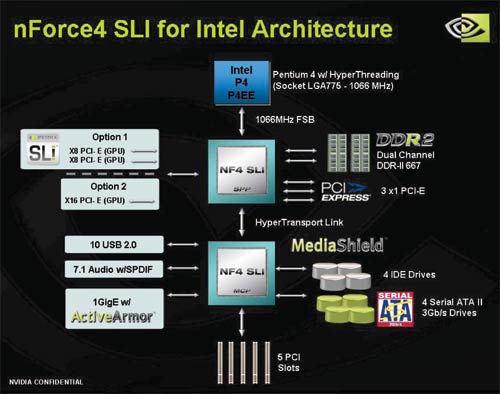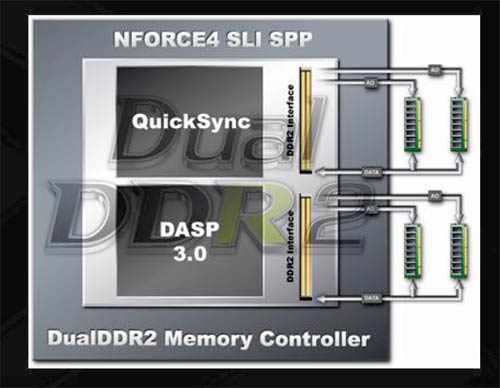Dual Core Intel Platform Shootout - NVIDIA nForce4 vs. Intel 955X
by Anand Lal Shimpi on April 14, 2005 1:01 PM EST- Posted in
- CPUs
NVIDIA's nForce4 SLI Intel Edition Chipset
As we've indicated in the past, NVIDIA's first Intel chipset is very similar to their nForce4 AMD chipset, with a couple of exceptions. For starters, the Intel Edition chipset is made up of two chips, compared to the AMD chipset's one. The reasoning is simple: with AMD's architecture, NVIDIA needn't include a memory controller in their chipset, which cuts down on overall die size quite a bit. With the Intel Edition, we see the first new memory controller that NVIDIA has introduced since nForce2.

Remember DASP? NVIDIA's Dynamic Adaptive Speculative Pre-Processor is back in nForce4 Intel Edition, but this time around, the competition is much stronger. DASP is a hardware pre-fetch engine that resides within the memory controller and attempts to pre-fetch data into a small amount of cache on the chipset, which NVIDIA's algorithms determine will be used by the CPU in the future. Intel has a similar technology in their 955X chipset, although it's not something they have branded or marketed. Depending on how aggressive NVIDIA's DASP is, it could make good use of the extra memory bandwidth offered by its dual channel DDR2-533/667 memory bus.

NVIDIA also boasts a dedicated address bus per DIMM slot with the nForce4; however, this seems to be a feature also supported by Intel, so there isn't much advantage over the competition here.
In their final memory controller optimization, NVIDIA's QuickSync claims to be able to reduce memory latency when operating in multiple clock domains (e.g. 800MHz FSB, but 533MHz memory bus). Later in this article, we'll find out exactly how aggressive NVIDIA's memory controller truly is.
The nForce4 SLI Intel Edition chipset supports both 800 and 1066MHz FSBs, just like the 955X - however, NVIDIA also indicated that if Intel were to increase the FSB frequency, they would be ready.
Unlike the 955X, NVIDIA only supports 3 PCI Express x1 slots. However, NVIDIA does offer two PATA channels, compared to Intel's single PATA channel. NVIDIA also offers more USB 2.0 ports (10 vs 8). NVIDIA does not support Intel's HD Audio spec, so you're stuck with AC'97 on the nForce4 SLI.










96 Comments
View All Comments
mkruer - Thursday, April 14, 2005 - link
The only reason why Intel allowed Nvidia to make a chipset for them was for the SLI. Intel is worried, and rightfuly so that Nvidia's SLI sloution for AMD whould give AMD an advantage.Questar - Thursday, April 14, 2005 - link
"Honestly, Intel processors and even the platform haven’t been interesting since the introduction of Prescott. They have been too hot and poor performers, not to mention that the latest Intel platforms forced a transition to technologies that basically offered no performance benefits (DDR2, PCI Express)."Your opinion only, don't make this out to be fact.
"at the end of the day, Intel would still be happier if there was no threat from companies like NVIDIA"
nVidia (please print it correctly) is not a "threat" to Intel in the chipset market. They couldn't make a P4 chipset without a license from Intel. If Intel was threatened by them they wouldn't sell them a license. The purpose in licensing is give system builders more choice in design features.
"However Intel’s chipset team has reason to worry; motherboard manufacturers weren’t happy with the 925/915 chipsets, and with a viable alternative in NVIDIA, we may very well have an opportunity for NVIDIA to start eating into Intel’s own chipset market share in a way that no other company has in the past"
Intel probably makes as much net profit off the licensing of the nVidia chipset as they do selling thier own - after all thay don't have to design, build, ship or sell anything. So why would they be worried?
Really Anand, you have to begin thinking these things trough.
Houdani - Thursday, April 14, 2005 - link
Grrr, I should have noted that I was referring to the NCQ testing.Houdani - Thursday, April 14, 2005 - link
Anand: For the Intel DC Preview, what would you say was the queue depth during the various multitasking tests? I'm curious how today's test compares with how you tested the Intel DC in the preview.Also, is the relation between a depth of 8 versus a depth of 32 linear? Would there be any value in testing a depth somewhere in the middle, such as 16 and/or 24?
Thanks yet again for the quality work!
ChineseDemocracyGNR - Thursday, April 14, 2005 - link
"NVIDIA does not support Intel’s HD Audio spec, so you’re stuck with AC’97 on the nForce4 SLI. "That's inexcusable for a $80 chipset, IMO.
ksherman - Thursday, April 14, 2005 - link
cool and all, but is there any variation of the Intel-based SLI vs the AMD Based SLI?